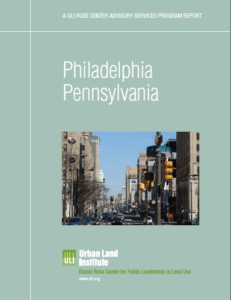Top Story
Location: Philadelphia, Pennsylvania
Sponsor: ULI Rose Center
Chair: Michael Banner
Subject Area: Economic Growth and Development
Download Panel Report (900 KB)
The Panel’s Assignment
Many parts of Philadelphia have seen a transformation in recent years. With its stable economic base, Center City has thrived as a walkable, vibrant commercial and residential area. Temple University, long a major regional force in higher education, has emerged as a nationally ranked university with undergraduate and graduate programs in numerous disciplines and expansive plans for growth at its north Philadelphia campus. Parts of north Philadelphia were redeveloped in the 1960s and have remained stable communities for middle-income and working-class families. Other nearby areas have seen pressures from gentrification and have become prized neighborhoods for artists, young professionals, and empty nesters. Some areas, however, have never recovered from the macroeconomic shifts of the late 20th century.
The project area is a 1.75-mile stretch of North Broad Street connecting City Hall and Temple University. Along this stretch can be found all the triumphs and failures of the city, including vacant land, population loss, and poverty, but also redevelopment, strong institutions, and—critically—excellent transit infrastructure. While there are six subway stations along this portion of North Broad, the areas around every station are underdeveloped and inconsistent with principles of transit-oriented development (TOD), and include much low-intensity, automobile-oriented development.
Within this context, Philadelphia’s Daniel Rose fellows asked the ULI Advisory Services panel to provide guidance on the following:
- Should an organization be formed to advocate a strategy for the North Broad Street corridor?
- What financial tools or mechanisms should the city consider using to revitalize North Broad?
- What specific places or projects can be identified that would maximize the leverage of public resources?
On a broader level, the city sees this area as a test case for new ideas about urban growth and transformation that recognize core principles of environmental sustainability and respect for the diversity that is essential to Philadelphia’s identity.
Summary of Recommendations
Based on briefings, site tours, and interviews with stakeholders, the panel identified the following as constraints for the redevelopment of North Broad:
- The need for better communication among stakeholders and with external parties.
- The age of the transit infrastructure and a perception of safety issues with the subway.
- Poor maintenance of the public realm and certain properties, and the perception of safety issues along the corridor.
- Parking conflicts among users along the corridor.
- Financial barriers and problems with access to capital for investment.
- Social equity concerns.
- The lack of a cohesive image and identity along the corridor.
- The lack of a private economic engine for the area.
The panel believes an effort to address these needs would best be served by creation of a broad-based stakeholder organization to advocate for and create change along North Broad. This organization could be seeded with foundation funding and staffed by the city and other stakeholders.
Compared with most other local and state governments, Philadelphia and Pennsylvania have created a relatively large toolbox for use in community development and public financing. Efforts to use that toolbox for North Broad should include:
- Using Keystone Opportunity Zones.
- Encouraging the Center City District and Temple University to play a greater role along the street until a local business improvement district (BID) can be supported.
- Using federal community development block grant (CDBG) economic development funds to create a partnership between the Philadelphia Industrial Development Corporation (PIDC) and Temple University for small business/entrepreneur support and to expand facade improvements.
- Using federal Renewal Community/Empowerment Zone tax credits to help businesses grow from Poplar to Master streets.
Some new tools the city should consider using include:
- Land swaps between public agencies.
- Parking authority bonds.
- Historic tax credit bridge guarantees.
- A bus shelter advertising revenue pilot program.
- Soft second and CDBG loan products to help bridge financing gaps.
The panel broke down the corridor into five development zones to address the unique conditions and opportunities in each segment:
- Convention Center Anchor Zone—City Hall to Vine Street.
- Redevelopment Loft Zone—Vine Street to Spring Garden Street.
- Redevelopment Neighborhood Zone—Spring Garden Street to Fairmount Avenue.
- Redevelopment Services Zone—Fairmount Avenue to Girard Avenue.
- Education Anchor Zone—Girard Avenue to Oxford Street.
In addition to recommendations for each of those segments, the panel listed the following overarching priorities for catalytic developments:
- Make the corridor clean and safe—maintain the public realm.
- Complete and support ongoing projects—for instance, subway station renovations, unified streetscape improvements, the People for People mixed-use development, the Cherry Street pedestrian plaza, and the Ninth and Berks development.
- Adopt a new TOD zoning overlay around stations.
- Make reuse/redevelopment of the William Penn High School site a key city initiative.
- Define city policy to promote parking partnerships along the North Broad corridor.
For all these recommendations, the convening and collaboration of stakeholders will be the key. Panel findings and conclusions are a case of first impressions. The extent to which they are well received and bear fruit will be attributable to the efforts of the city and stakeholders acting on what they deem most useful.
